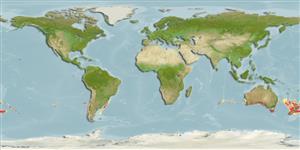>
Gadiformes (Cods) >
Macrouridae (Grenadiers or rattails)
Etymology: Lucigadus: Latin, lucius, Greek, lykos = wolf; pike + Latin, gadus = a fish cod?. By its predatory habits (Ref. 45335).
Environment: milieu / climate zone / depth range / distribution range
Écologie
marin bathydémersal; non migrateur; profondeur 200 - 1463 m (Ref. 33740), usually 400 - 800 m (Ref. 1371). Deep-water; 28°S - 47°S
Indo-West Pacific: southern Australia and New Zealand. Southeast Pacific: Chile.
Taille / Poids / Âge
Maturity: Lm ? range ? - ? cm
Max length : 34.0 cm TL mâle / non sexé; (Ref. 1371)
Description synthétique
Morphologie | Morphométrie
Épines dorsales (Total): 2. Scales small, with slender conical spinules arranged in 11 to 12 subparallel rows. Snout without prominent markings; first dorsal fin with a prominent black blotch distally.
Occurs on the continental slope (Ref. 9563).
Life cycle and mating behavior
Maturité | Reproduction | Frai | Œufs | Fécondité | Larves
Iwamoto, T. and A. Williams, 1999. Grenadiers (Pisces, Gadiformes) from the continental slope of western and northwestern Australia. Proc. Calif. Acad. Sci. 51(3):105-243. (Ref. 35909)
Statut dans la liste rouge de l'IUCN (Ref. 130435)
Menace pour l'homme
Harmless
Utilisations par l'homme
Pêcheries: intérêt commercial mineur
Plus d'informations
Taille/ÂgeCroissanceLongueur-poidsLongueur-longueurFréquences de longueursMorphométrieMorphologieLarvesDynamique des populations larvairesRecrutementAbondanceBRUVS
RéférencesAquacultureProfil d'aquacultureSouchesGénétiqueElectrophoresesHéritabilitéPathologiesTraitementNutrientsMass conversion
Outils
Articles particuliers
Télécharger en XML
Sources Internet
Estimates based on models
Preferred temperature (Ref.
123201): 6.3 - 9.9, mean 8.1 °C (based on 120 cells).
Phylogenetic diversity index (Ref.
82804): PD
50 = 0.5039 [Uniqueness, from 0.5 = low to 2.0 = high].
Bayesian length-weight: a=0.00219 (0.00111 - 0.00431), b=3.20 (3.03 - 3.37), in cm total length, based on LWR estimates for this (Sub)family-body shape (Ref.
93245).
Niveau trophique (Ref.
69278): 3.5 ±0.5 se; based on size and trophs of closest relatives
Résilience (Ref.
120179): Faible, temps minimum de doublement de population : 4,5 à 14 années (Preliminary K or Fecundity.).
Fishing Vulnerability (Ref.
59153): Low vulnerability (24 of 100).
